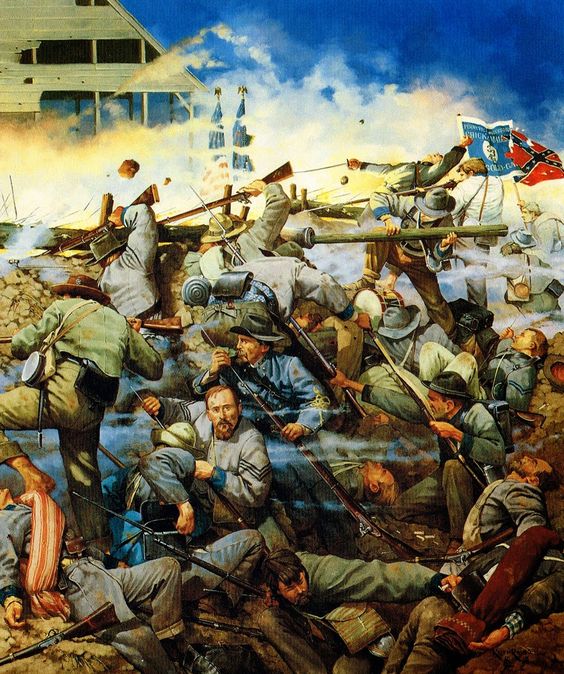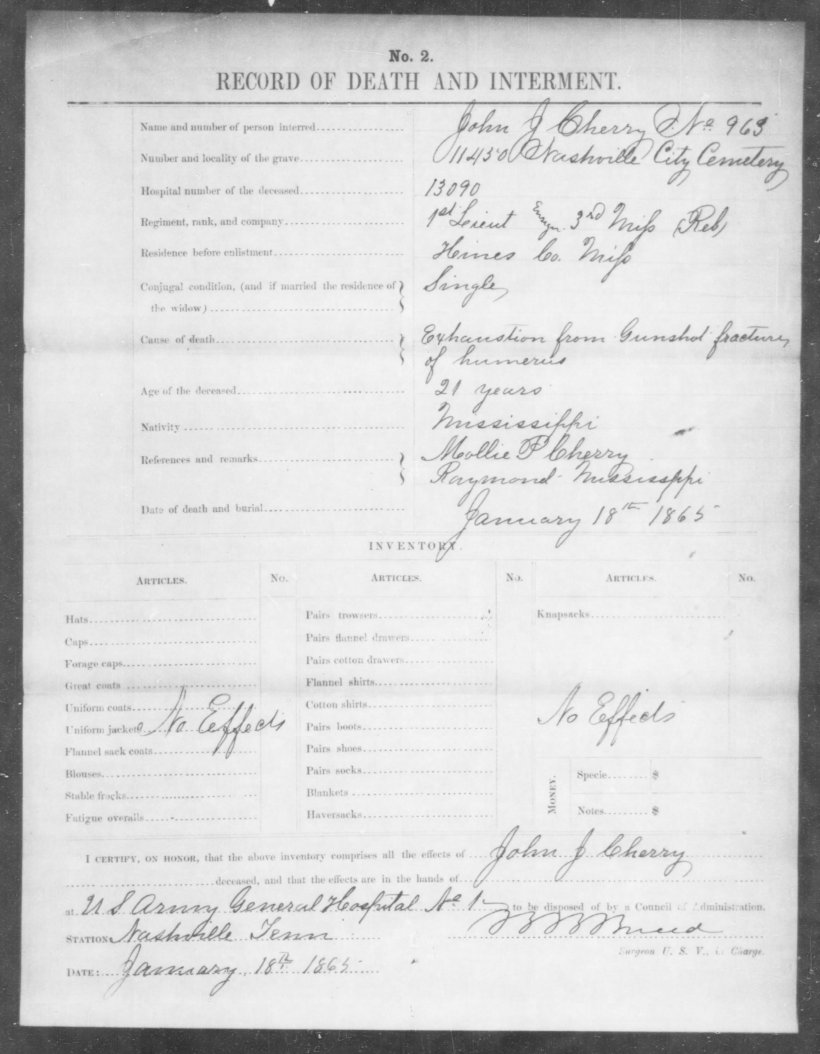Today is Memorial Day, set aside in observance of those men who have given their lives in defense of our country. In this posting I will tell you about a soldier from my hometown who gave his life in defense of his country: John J. Cherry of Bolton, Mississippi.
John J. Cherry enlisted in the Confederate army in the fall of 1861 as 2nd Sergeant of the “Downing Rifles,” Company C, 3rd Mississippi Infantry. He must have been a good soldier, for in April 1864, Colonel Thomas A. Mellon, commander of the 3rd Mississippi, recommended Cherry for a new position created by the Confederate Congress; that of Ensign. This was a rank unique to the Confederate army, and was intended to be held by a man who had displayed his courage on the battlefield. Ensign was an officer’s rank, although the post did not have any command responsibilities – the job was to carry the regiment’s colors in battle, a post of great honor and even greater danger.

In recommending Cherry for the position of Ensign, Colonel Mellon wrote a letter of recommendation to General Samuel Cooper, Adjutant and Inspector General of the Confederate army. He said the young sergeant was
“in every particular fully qualified for the position, having always been a good and faithful soldier, and has displayed on several occasions, gallant and meritorious conduct.” (Service Record of John J. Cherry, 3rd Mississippi Infantry, accessed on Fold3.com)
Cherry showed that Colonel Mellon’s faith in him was justified at the battle of Franklin, Tennessee, November 30, 1864. The Confederate army under General John J. Hood attacked a strongly entrenched Federal force at Franklin, and it was the fate of the 3rd Mississippi to be ordered to attack one of the strongest parts of the Union line. The regiment suffered terribly in this attack: 13 men killed, 40 wounded, and 20 missing. (Military History of Mississippi, page 153). Among the casualties was Ensign John J. Cherry, shot in the arm and captured during the fighting. He was mentioned in the official report of his brigade commander, General Winfield Scott Featherston, who wrote, “The color bearers of the Third and Twenty-Second planted their colors on the enemy’s works and were wounded and captured with their colors.” (Military History of Mississippi, page 152)

John J. Cherry was taken to a hospital in Nashville by the Federals, where he succumbed to his wounds on January 18, 1865. The cause of death was listed as a fracture of the right humerus caused by a gunshot. Ensign Cherry is buried in Olivet Cemetery in Nashville, Tennessee.

In looking for more information about the life of John J. Cherry, I found an interesting article written by Sallie B. Morgan of Clinton, Mississippi, in 1887. Her article was about the flag of the 3rd Mississippi Infantry which was in the collections of the state historical museum, having recently been returned to the state by the veterans of the 9th Connecticut Infantry, who had captured it in 1862. Miss Morgan went to great lengths to point out this this was not the flag carried by John Cherry at the battle of Franklin:
Speaking of history and its errors, and they are many, reminds one of a flag in the Capitol at Jackson, which is calculated to mislead the future historian of Mississippi. It purports to be the regimental colors of the Third Mississippi, and has words to that effect on the ground of white, on which the Ninth Connecticut puts the remains of the flag when they returned it to the Third Mississippi at New Orleans in 1885. They stated they captured it at Pass Christian during the war. All that is left is a large magnolia, the gilt fringe and some shredings of the flag, held together by a new staff and new ground.
Now that the regiment appreciates the thoughtful kindness of the Ninth Connecticut in returning the relic, I do not doubt; but as a matter of history, injustice will be done a brave Confederate, John Cherry of Bolton, who fell with the colors at Franklin, Tenn., more than two years after this flag was carried away…It will be but justice to the brave man who carried the regimental colors for so long, and who plunged over the parapets at Franklin, still holding them in his dying grasp.

Morgan went on to point out why it was so important that Southerners remember those that fought for them in the war:
Each day something occurs which impressed upon us the necessity of keeping the history of our country before the young people of the land. It should not be left to legendary and traditionary lore. Each generation changes some of the traditions, adds or subtracts legends, until facts become fiction. Though on the main and most important events we have are undisputed and incontestible history in ‘The Rise and Fall of the Confederate States of America,’ yet there are many little memories of our country and soldiers in those dark and trying hours, well worth preserving. Each soldier can bring his offering, each family can add its mite. In a few years all the relics of the Confederacy will have passed away unless we take some means of preserving them. A museum at Jackson would be noble monument to our Confederate dead. (The Clarion, Jackson, Mississippi, May 18, 1887)
I am happy to report that the memory of Ensign Cherry and his comrades in the 3rd Mississippi Infantry have been kept alive by my good friend Grady Howell. He wrote an excellent history of the regiment, “To Live and Die in Dixie,” and if you have never read it, I highly recommend that you pick up a copy. I am also very glad to say that the state of Mississippi does have a history museum in Jackson, and the story of Mississippi’s role in the Civil War is very well told in that facility. If you have not been there yet, you are missing out, as their are many interesting stories of Mississippians told in that building.



